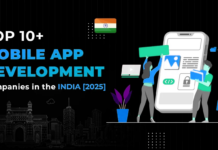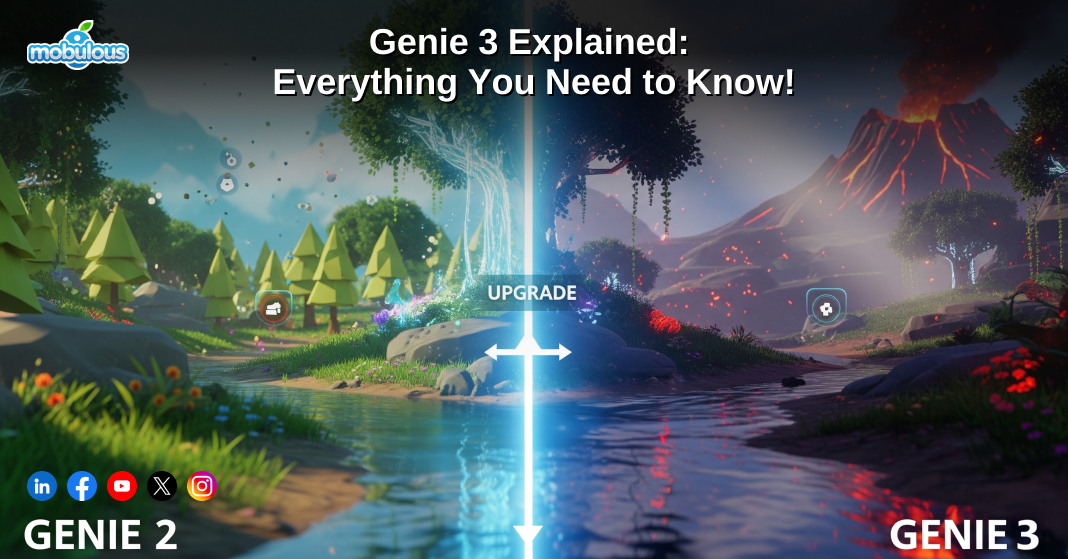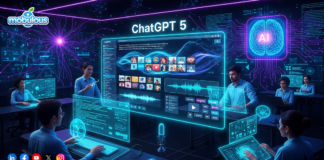What is Genie 3? What Can It Do?
Genie 3 is the latest general-purpose world model from Google DeepMind, built to simulate interactive environments in real time. Unlike its predecessors, it doesn’t just render worlds, but it lets users explore them actively. From navigating volcanoes to simulating magical forests, Genie 3 is pushing how AI understands and simulates reality.
This model can take a descriptive text prompt and turn it into a navigable, dynamic world running at 24 frames per second in 720p. It can hold onto environmental consistency for a few minutes, offering a glimpse of what’s possible when AI models can simulate complex physical and imaginative spaces that respond to user interaction.
To explore how AI can bring your own interactive world simulations to life, check out an AI & ML development company and start building the future today!
Genie 3 Key Features
1. Real-Time Interaction
Genie 3 supports fully interactive experiences at 24 FPS, letting users move and react inside environments instantly. It offers smooth and immediate feedback, similar to video games, elevating the realism of each generated world.
2. Consistent Environments
Unlike previous models, Genie 3 keeps environments physically and visually consistent for minutes. Objects remain where they should, and landscapes evolve logically, thanks to a memory mechanism tracking up to a minute of past context.
3. Promptable World Events
Users can introduce events or changes into the scene using text prompts, like changing the weather or adding new elements. This gives creators more control, making each simulation unique and adaptive to input.
4. 720p Video Generation
Worlds are generated at a high visual resolution of 720p, enhancing clarity and immersion. Whether exploring a zen garden or braving a hurricane, Genie 3 delivers crisp, detailed environments that pull users in.
5. Embodied Agent Compatibility
Genie 3 is designed to work with agents like SIMA, letting them interact in these environments to pursue goals. The model simulates environments based on agent actions, enabling practical AI testing and development.
6. Dynamic Scenario Diversity
From serene forests to underwater canyons, Genie 3 can generate nearly any environment imaginable. Whether grounded in reality or pure fiction, it responds accurately to prompts, offering massive creative freedom.
Read more: What is Google MUVERA? Everything You Need to Know in 2025
How Genie 3 Works
Genie 3 builds its world frame by frame using a technique called autoregressive generation. That means it considers the previous frames and user actions to decide what comes next. This allows it to respond in real time to navigation input or text-based world events while preserving consistency.
The model constantly updates itself as new data arrives, whether you’re walking, jumping, or spinning around. Genie 3 doesn’t rely on pre-made maps or static settings. Every element, from shadows to terrain changes, is generated dynamically to reflect what you see and do.
By embedding a visual memory of up to one minute, it avoids the jarring inconsistencies that earlier models suffered from. This lets users revisit areas and find things just as they left them. Genie 3 essentially simulates an evolving mini-universe based entirely on user interaction.
Genie 3 Use Cases
1. AI Agent Training
Genie 3 can simulate environments where agents are trained to complete complex tasks. From navigation to problem-solving, these virtual worlds give AI systems the perfect space to learn and adapt.
2. Game Development
Developers can create dynamic game environments without needing massive design teams. Simply describe the scene or challenge, and Genie 3 builds it, saving time and boosting creativity for indie creators and studios alike.
3. Educational Simulations
Teachers and learners can explore historical sites, natural ecosystems, or scientific processes in a first-person view. Genie 3 makes abstract concepts visual and interactive, enhancing engagement in learning.
4. Cinematic Worldbuilding
Filmmakers and animators can create scenes by typing ideas instead of manually animating them. Whether it’s a sci-fi city or a medieval village, Genie 3 builds rich, believable backdrops in minutes.
5. Creative Storytelling
Writers and creators can explore and visualize fictional worlds before committing them to paper. Genie 3 acts like a creative partner, bringing narrative settings to life with stunning realism and flexibility.
6. Robotics Simulation
Before testing robots in real-world environments, developers can simulate rough terrain, obstacles, or weather in Genie 3. It’s a cost-effective way to prep hardware and agents for real-world deployment.
How to Use Genie 3
To use Genie 3, you start by entering a text prompt that describes the world or scene you want to generate. Within moments, Genie 3 builds a fully interactive environment you can explore in real time, moving through it like you would in a video game.
If you want to make changes, like adding a rainstorm or introducing new objects, you just type a new prompt. These promptable world events let you adapt the scene on the fly, without stopping or reloading the experience.
You can also integrate Genie 3 with AI agents like SIMA, letting them perform tasks inside the world by sending movement and interaction commands. For now, Genie 3 is in limited release, available to select researchers and creators.
Genie 3 Pros & Cons
| Pros of Genie 3 | Cons of Genie 3 |
| Real-time interaction | Limited interaction duration |
| High visual consistency | Geographic accuracy is not perfect |
| Promptable world events | Text rendering can be unclear |
| Wide scenario diversity | Complex agent modeling is still limited |
| Supports agent training | Limited direct action range |
Limitations of Genie 3
1. Short Interaction Window
Genie 3 can only maintain real-time interaction for a few minutes. This limits longer simulations or extended gameplay scenarios, though it’s a big step forward compared to older models.
2. Limited Action Scope
While you can explore and prompt events, the direct actions your agent can take are still quite limited. That means some tasks or interactions can’t yet be performed fluidly by the agent itself.
3. Imperfect Real-World Mapping
Although Genie 3 produces realistic environments, it doesn’t precisely replicate actual locations. So, while Venice or the Alps might feel authentic, they won’t match satellite data or street views.
4. Text Display Challenges
Genie 3 struggles with rendering legible text unless it’s included as part of the prompt. Classroom blackboards or signs might show up, but don’t count on dynamic in-world text changes.
5. Agent Interaction Complexity
Simulating multiple independent agents interacting with each other is still an open challenge. Genie 3 focuses on single-agent environments for now, with complex social dynamics to be tackled later.
6. Visual Drift Over Time
Though consistency has improved, visual or physical inconsistencies may still creep in the longer the session runs. This is a known issue with autoregressive models and is being actively researched.
Genie 3 vs Veo 3
| Feature | Genie 3 | Veo 3 |
| Interaction | Fully interactive in real-time | Passive video generation |
| Duration | A few minutes of sustained coherence | 8 seconds of temporal coherence |
| Resolution | 720p dynamic scenes | 720p to 4K but fixed perspectives |
| Use Cases | Agent training, exploration, simulation | Cinematic video, storytelling |
| Promptable Events | Yes, with dynamic reactions | No live interactivity |
| AI Agent Integration | Supports SIMA and others | Not designed for agents |
Read more: What is Google Veo 3? Everything You Need to Know in 2025
Future of Genie 3
1. Expanded Access
Right now, Genie 3 is only available to select researchers and creators. In the future, wider access is expected to allow more developers and educators to benefit from its capabilities.
2. Improved Memory Length
While it can remember scenes up to a minute, future versions could support longer memory. This will allow even more consistent and immersive experiences over extended interactions.
3. More Complex Agents
Genie 3 currently handles single-agent setups. Future iterations aim to include complex social dynamics and multi-agent interactions, which will unlock new use cases in simulation and gaming.
4. Greater Realism
While already impressive, visuals and physics will only improve. Expect more photorealistic rendering, nuanced character animations, and natural phenomena simulation in upcoming releases.
5. Richer Prompt Controls
Soon, you might be able to control even more world elements with layered prompts by adjusting emotions, time of day, or even plot beats, making storytelling truly interactive.
6. Longer Scenarios
Future improvements will focus on sustaining longer sessions, perhaps even hours of uninterrupted interaction. This could make full-length games or simulations entirely prompt-generated.
Conclusion
Genie 3 isn’t just a cool tech demo, but it’s a major leap toward an interactive, AI-driven world simulation. From education to agent training, from entertainment to robotics, it’s setting the stage for what’s possible with generative environments. It’s smart, responsive, and already pushing boundaries that seemed unreachable a year ago. While it’s not perfect yet, Genie 3’s real-time consistency and versatility mark a powerful new phase for world models. The future of simulation and maybe even AGI starts here.
Want to create your own immersive experiences? Connect with a leading web app development company and start building your interactive world today
FAQs – Genie 3
Q1. What is Genie 3?
Genie 3 is a general-purpose world model from Google DeepMind. It generates real-time, interactive environments based on text prompts, allowing users and AI agents to explore and interact with rich, dynamic virtual worlds.
Q2. Can Genie 3 create full video games from text?
While Genie 3 can generate playable, interactive environments from text, it doesn’t build full-fledged games with objectives, scoring, or progression systems. It’s more of a simulation engine that could power parts of a game experience.
Q3. Is Genie 3 available to the public?
Currently, Genie 3 is being offered as a limited research preview. A select group of researchers and creators is testing it, while broader availability is planned for the future after more testing and feedback.
Q4. When will Genie 3 be fully released?
There’s no confirmed public release date for Genie 3. Google DeepMind is currently working with a small cohort to explore responsible use and gather feedback before considering broader access.
Q5. Is Genie 3 free to use?
As of now, Genie 3 is not publicly available, so pricing hasn’t been announced. Access is limited to a few testers and researchers through Google DeepMind’s preview program.
Q6. Genie 3 vs Veo 3: What’s the difference?
Genie 3 is built for interaction and real-time simulation, allowing users and agents to explore environments. Veo 3, on the other hand, focuses on generating high-quality video with no interactivity, making it better suited for cinematic content.
































